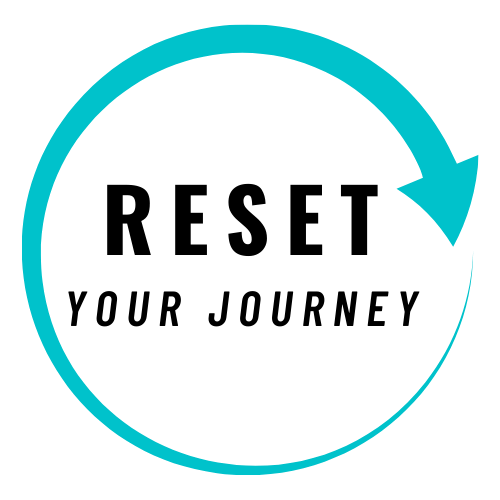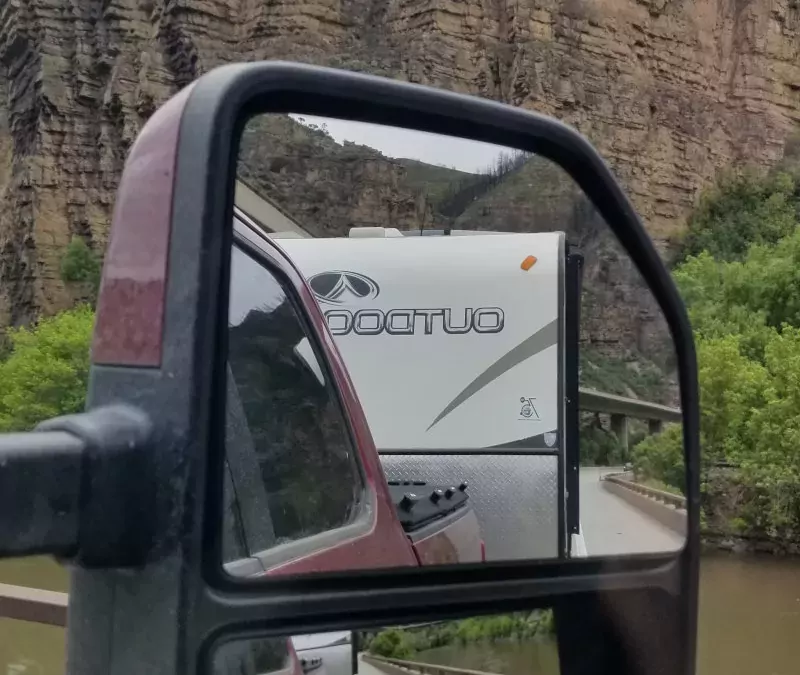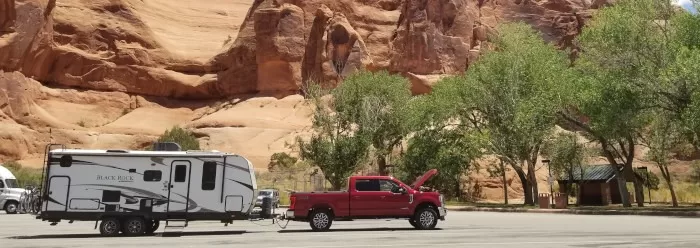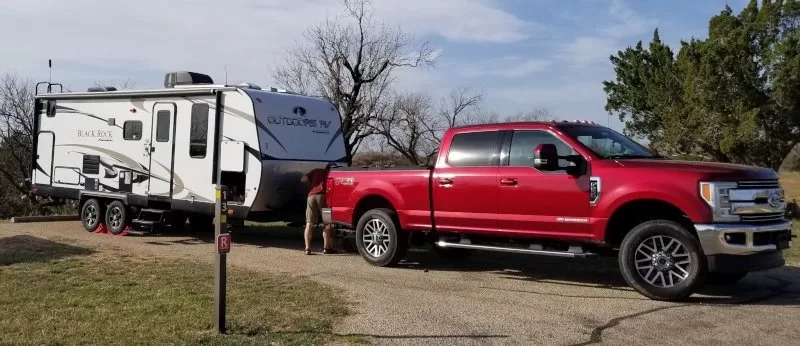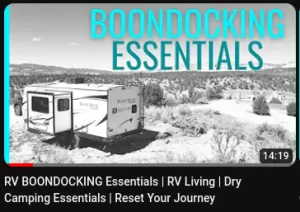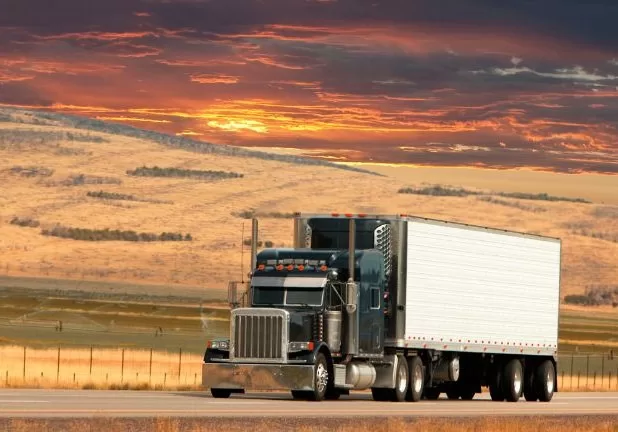Last Updated on 05/09/2024 by Glynn Willard
Travel Trailer Towing Tips
If this is the first time that you’ll be towing a travel trailer, read on.
You’re not alone!
I had never towed anything before I bought my travel trailer and towed it home from over 400 miles away.
Let’s just say, I was thrown to the wolves.
I hope my crash course in towing helps resolve your anxiety and keeps you out of sticky situations.
If you’re looking at a fifth wheel, most of this article still applies.
How I Went From Never Towing To Towing Full-Time
Towing a new trailer to our home (DE) from NH without any experience was certainly a nail-biter!
The only large vehicles I ever drove were U-Haul trucks when we moved to new houses.
A large U-Haul is easy compared to two separate vehicles with a pivot point in the middle!
Fortunately, the drive home was ninety percent highway, albeit there’s nothing easy about navigating highways in the Northeast with a large vehicle.
I had my Father back the trailer into the tight driveway and even he had a hard time.
My stomach knotted up just watching him.
How was I supposed to master such a precise maneuver in a short time?
Well, I did what most smart people do and spent time practicing in an empty parking lot.
The amount of time in that empty lot was priceless. We practiced so many different scenarios until it became easy.
That said, it still took me a good two months of full-time to gain a better understanding of the best way to maneuver our travel trailer.
But the next twenty-two months were a breeze!
Know Your Trailer And Tow Vehicles Dimensions
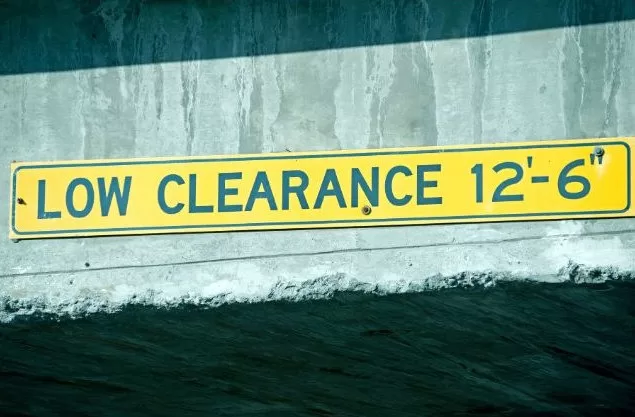
Before you take your first road trip, make sure you know the dimensions of your travel trailer.
Put a sticky note on your dashboard with the following parameters:
- Height of your trailer to include the highest object. It was our weBoost antenna for us.
- Width and length of your trailer (trailer hitch to bumper).
- Total length of tow vehicle and trailer combined.
You’ll encounter situations such as low overpasses or tunnels that limit your length and height.
Having these numbers memorized or on the dashboard of your pickup truck will keep you out of sticky situations.
Some RV-specific navigation systems or apps allow you to input your rig’s dimensions and it will route you clear of potential hazards.
Hitching To Your Towing Vehicle
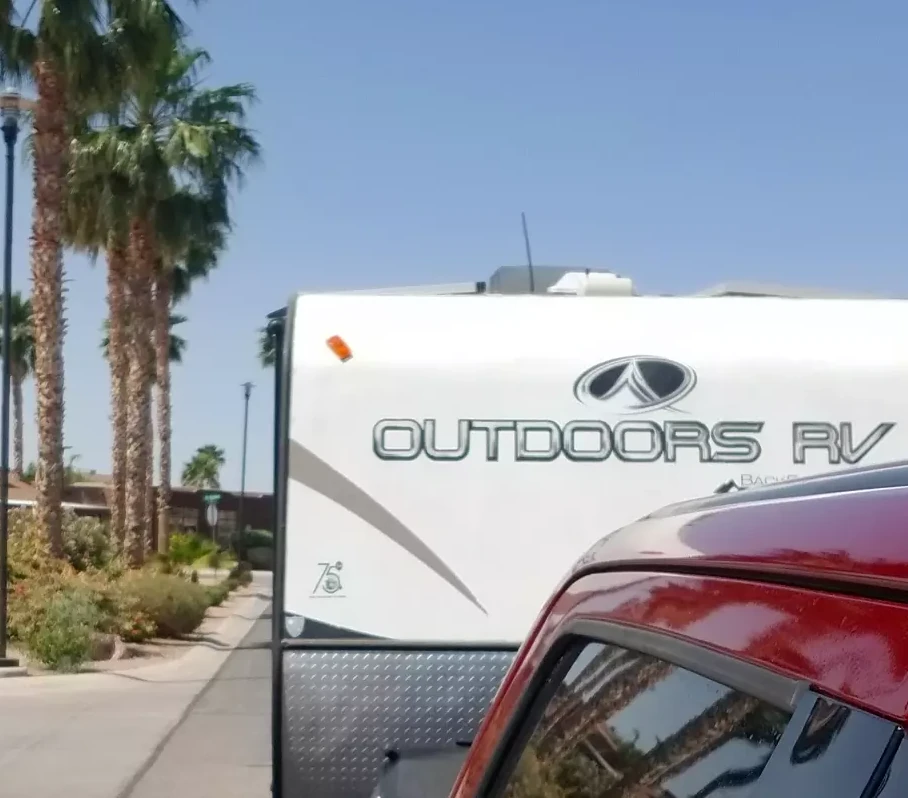
When you’re ready to connect the trailer, here’s an easy list to follow for new RVers.
- Make sure the trailer wheels are chocked.
- Raise the trailer tongue hitch with the tongue jack high enough to clear the truck’s ball mount.
- Back the truck up so that the receiver hitch (ball mount) is directly under the trailer hitch. Use the camera or recruit help from someone with clear hand signals.
- Set the truck’s emergency brake.
- Lower the trailer coupler onto the ball mount, engage the hitch latch, and apply the hitchpin.
- Connect the safety chains, emergency breakaway cable, and wire harness.
- If you have a weight distribution hitch, use the tongue jack to lift the trailer and truck just a bit. This will ease tension, making it easier to install the spring bars.
- Raise the tongue jack off the ground or leveling blocks and remove the blocks.
- Do a safety inspection, checking all aspects of the tow vehicle, hitch system, trailer, brake lights, and turn signals.
- Remove all wheel chocks.
- Set the truck into tow mode.
- Move forward slightly and test your truck’s brakes and the trailer’s brakes.
- Set up for the backup by creating additional space for the front of your truck by placing the truck closer to the side you’re backing into.
- Just as you are slowing to a stop from aligning your truck close to the side you’re backing into, turn the wheel toward the opposite direction.
- Steering wheel hand placement makes a difference. Whenever I got confused, I placed a hand on the bottom of the steering wheel and pushed it in the direction I wanted the back of the trailer to go.
- Most of the time, Rose got out and directed me with hand signals or with a cell phone.
- In tight situations, rather than losing my temper, I was nice to other drivers and they always helped, waited, or moved when necessary.
- Micro-adjustments while backing slowly is the key. Wait until your proficient to move faster.
- Accelerate to approximately ten miles per hour.
- With your foot off the brakes and accelerator, apply the trailer brake controller.
- The trailer’s brakes should bring your truck to a stop without locking up the trailer brakes.
- If they don’t stop the truck, raise the brake gain a little and continue trying until it does without locking up.
- You should adjust your brake gain when the trailer weight is where it’s going to be most of the time.
- If the weight of the trailer changes, adjust the gain up or down accordingly. After a while, you’ll develop a natural feel of where it should be.
- Knowing you make wide turns, get as far left as you safely can before turning the wheel to the right.
- Enter into the intersection as far as you safely can, leaving you plenty of space.
- Make the turn and simultaneously watch the front left bumper and the right side view mirror, making micro adjustments as needed.
- It’s okay to cross into oncoming traffic when it’s clear if necessary to make sure you have plenty of room. You’ll know what’s safe and what is not when you’re in the situation.
- Being polite and waving to other drivers will go a long way and is the key to maximum cooperation.
- Gross Vehicle Weight Rating (GVWR): The total weight your truck or trailer can safely carry including the truck/trailer itself, the passengers, all fluids, and all cargo.
- Gross Axle Weight Rating (GAWR): The max amount of weight each axle can safely handle. This applies to both the truck and the trailer.
- Gross Combined Weight Rating (GCWR): The max weight of the combined truck and trailer weight.
- Tongue Weight: The amount of force pressing down on your truck’s hitch from the trailer. You must factor this amount into the cargo weight of the truck bed.
- When ascending a steep grade, pull over frequently to allow faster traffic to pass. You know you would appreciate it done for you.
- If it’s a long ascent, stop at the top to let your engine cool. Keep it running, so that the fan does what it’s supposed to do.
- Learn to use your engine brake properly and keep it engaged during the descent.
- Keep a lot of distance between you and the next vehicle. You’re heavy and will take a long time to stop in an emergency.
- Maintain a safe slow speed the whole time.
- Be aware of upcoming sharp turns and approach them under complete control.
- Allow traffic that has built up behind you to pass on occasion.
- Blind Spots: Practice using your side-view mirrors and get to know where your blind spots are for the trailer.
- Trailer Sway: If you feel like trailer sway is developing, take your foot off the accelerator and gently apply the trailer brake controller. It will help straighten the trailer and eliminate sway.
- High Speeds: You have no business speeding when towing a travel trailer. Maintain a safe speed even if it’s below the posted speed limit. Tractor trailers are better equipped to speed and professionally trained.
- High Winds: Try to avoid moving on windy days. If you must, drop your speed. We found that traveling with full freshwater tanks helped keep the center of gravity low and heavy. The trailer better tolerated high winds. But we still avoided it when we could.
- Inclement Weather: If you’re traveling in snowy or icy conditions, you may have a legal obligation to use safety chains. It’s a good idea to keep a set if you know you’ll be in a region with those potential conditions.
- Tight Turns: It’s okay to stop or disrupt traffic to safely execute a tight turn. I mentioned previously in the article how to maneuver challenging turns.
- No Outlets: Use extreme caution on back roads and watch for no outlet signs. It helps to have your navigator check the satellite image when you’re unsure. We had to execute a 64,000-point turn in Idaho on a no-outlet road. It wasn’t fun!
- Low Overhead: Low bridges are not your friend! Watch for signs and avoid roads that don’t allow trucks or commercial vehicles. Using an RV trip planner navigation system, such as RV Trip Wizard will keep you out of sticky situations.
- Narrow Roads: Take your time on narrow roads and allow traffic behind you to pass when you have the opportunity. Make it a habit to use your mirrors to get a feel for how close your trailer tires are to the edge.
- Tight Gas Stations: We found fuel prices to be cheaper at smaller stations further off the highway. But this means you need to be comfortable navigating the tight spaces. When in doubt, pass it and look for the next station.
Rose (my beautiful navigator) would usually look ahead at the satellite image to see if we would fit. During desperate situations, she even kindly stopped traffic, so that I could manipulate into or out of a tight spot. - Practice using your side mirrors from every angle and use them frequently.
- Limit the distance on moving days. Arriving at your destination super-fatigued because you towed too long opens the opportunity for mistakes. Sure, you can drive your car 400-500 miles in a day, but that does not apply to towing.
We make sure to max our moving days out at 300 miles. We average 50 miles an hour with stops and a slower speed.Remember, you still have to maneuver your trailer into tight spaces and get it leveled. Arrive relaxed and rested and it will be no problem.
- Treat everyone around you on the road with kindness and drive defensively, understanding that most drivers have never towed a heavy trailer.
- Come to a complete stop and pay close attention before entering any traffic pattern (to state the obvious).
- If you do end up dealing with law enforcement, act professionally. Being kind will get you a lot further than being a jerk.
You can learn more in our article: Travel Trailer Setup Checklist For Camping (Free For Phone)
This way you’ll be ready for the first step when you arrive at your destination.
Tips For Backing Up A Travel Trailer
Admit it along with me, this is the scariest part of towing a trailer for a new RV owner.
It takes more than a little practice before you’re comfortable.
Yes, practicing in a parking lot helps a lot, but true comfort doesn’t arrive until you’ve been towing week after week on the open road.
Here are the things that helped me when maneuvering into a tight spot:
Tow Vehicle And Trailer Brakes
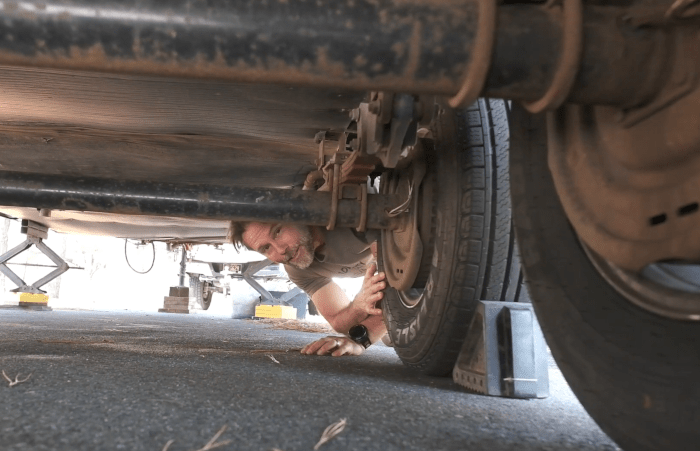
Proper maintenance of your tow vehicle brakes and trailer wheels and brakes is crucial!
You’ll be quickly reminded of this fact the first time you’re descending a six-mile 9% grade.
Before I go any further on the wheels, let’s talk about the tow vehicle.
If it’s within your means, find a pickup truck with an engine brake.
They’re available in both flavors (gasoline and diesel) and will make hill descent a piece of cake!
Also, a super-duty truck has more substantial brakes to accommodate for the additional weight.
Whether you do it yourself or have it done for you, check the condition of your trailer’s brakes, hubs, and bearings as part of your regular preventive maintenance.
If you move a lot, do it every 3-6 months. If you don’t move frequently, do it annually.
Ask me how I know!
Tips for setting brake gain.
If your tow vehicle is equipped with a trailer brake controller, you’ll have the ability to set the gain.
Don’t skip this part.
Tow your trailer to a location with little to no traffic where you have a long straight line.
The goal is for the trailer brake system to stop the trailer and for your truck brakes to stop the truck. Each being self-reliant.
Again, make it a priority to get to know your brakes and wheels. It could save your life or another driver’s life.
Making Tight Turns With A Camper

Left turns are easy and you’ll figure this out quickly.
But right turns require a little more calculation.
Yes, you may encounter situations where you have to wait for traffic to clear so that you can cross the yellow line.
When you’re approaching a tight right turn:
I remember being in a small town in Colorado and watching someone making a right turn with a travel trailer.
They didn’t do anything listed above and ended up scraping the entire side of the trailer along a railroad crossing sign.
They even broke the sign off of the post!
It would have been so easy to prevent such a mishap!
Fuel Economy While Towing
It’s no secret that your gas mileage will diminish drastically when you’re towing your camper.
We towed our Outdoors RV with an F250 with a diesel engine. I would have preferred an F350, but it still did great!
When we were not towing, I averaged 18 miles per gallon of diesel.
But as soon as that trailer was connected I averaged 10 miles to the gallon. Ouch!
Accept this and go into RVing knowing that your fuel economy will suffer no matter what.
Budget for it and you’ll be fine.
The Weight Of Your Travel Trailer
If you’re new to towing, the likelihood of the salesperson for your truck (and RV) knowing the legitimate stats for your truck and rig is limited.
This makes it your responsibility to understand the following terms:
Tire Pressure is another very important aspect of safe towing.
Many of the complaints about travel trailer tire blowouts result from improper tire pressure and an over weighted trailer.
Yes, there are cheaply made tires, but you have control of proper inflation and the amount of weight in your rig.
Use the tire manufacturer’s charts for proper tire pressure based on the weight of your trailer divided per tire.
Your tires will talk to you if you listen. Watch for unusual wear and adjust the pressure accordingly.
Also, be aware that your suspension system may need adjustment or greasing (wet bolts).
If you’re changing regions and elevations frequently, adjust your tire pressure as needed.
We always travel with an air compressor in our truck.
With all of this said, remember that too much weight in a travel trailer is dangerous. For that matter, too much extra weight is dangerous for all recreational vehicles.
Make a conscious effort not to exceed your GVWR for the truck and trailer.
Not Sure What You Need For Your RV?
Towing A Trailer Over Steep Hills
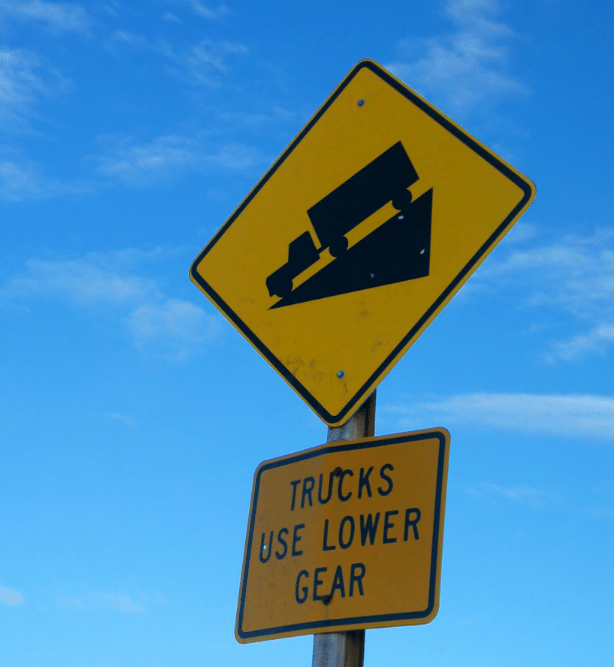
I mentioned earlier to make sure your brakes are in good condition before conquering steep mountain passes.
There are a few considerations to keep in mind:
Your goal is to use your brakes as little as possible while maintaining a safe speed.
With a little practice, you’ll master towing over mountain passes in no time.
Some Dangerous Situations While Towing
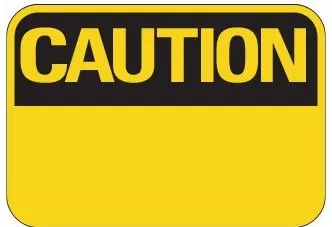
Here are some important things to consider and be aware of when towing:
You may find a few other challenges while towing, but that list covers some of the more “global” challenges.
Truck Stops and Commercial Truckers
Be courteous and respectful when sharing the road with commercial truck drivers!
They are on a deadline and are regulated as to the amount of time they can drive.
When one passes you and needs to get back over to the right lane, flash your lights as soon as they’re clear to get back over.
Never pull right in front of them and slow down. Respect the amount of space they need to keep in front of them.
Truck Stop Etiquette
Truck stops sometimes have designated RV parking. Use it or park off to the side somewhere.
Spots specifically for commercial trucks should be left to them, not your RV.
This especially applies if it’s later in the day and they are required to stop for the night.
Those spots fill quickly and completely along major routes. Again, they’re not for you.
They’re for commercial truckers required by law to stop for the night.
Safe Towing Is Your Responsibility
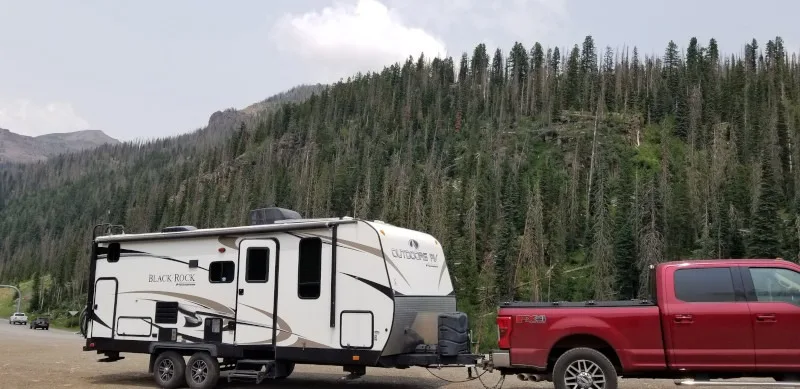
Here are a few more tips to stay safe and tow like a pro:
Wrapping Up Tips For Towing A Camper Trailer
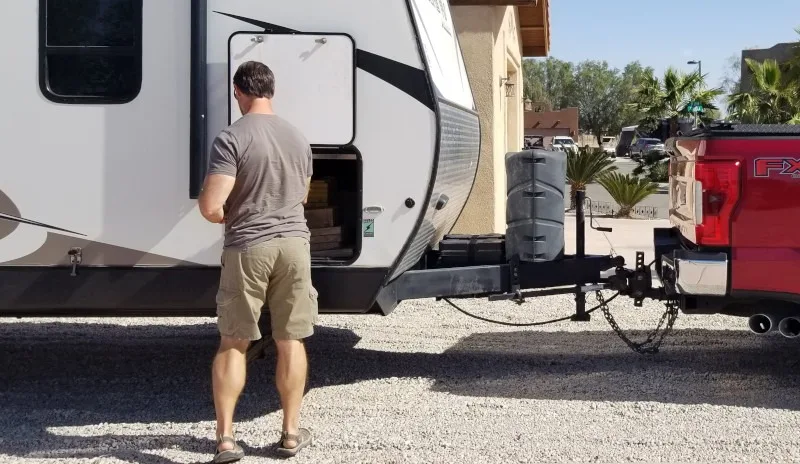
As you can see, there’s a lot more to towing a trailer safely than just hitching it to your truck and going.
Get as much practice as you can in the beginning.
But know that you’re real-world experience will come when you’re out on the open road.
Take your time, be courteous, and avoid losing your patience and you’ll be a pro in no time!
What tips and tricks do you have for safe towing?
Meet the author.
We appreciate any help in bringing you great content. Donate or buy us a coffee on our Ko-Fi site. Or subscribe to our YouTube Channel.
Thank you so much for being here!

